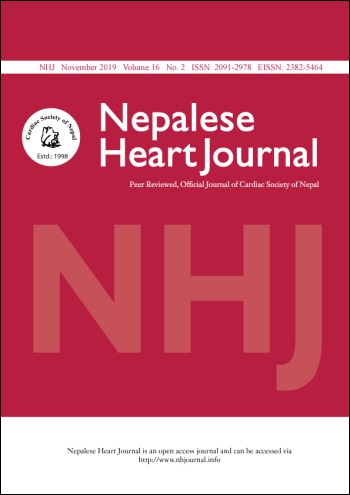Coronary Artery Disease prevalence in Heart Failure with Reduced Ejection Fraction
DOI:
https://doi.org/10.3126/njh.v16i2.26314Keywords:
Coronary Angiography, Cornonary artery disease, Heart failure with reduced ejection fraction, Prevalence, PredictorsAbstract
Background and Aims: Even though heart failure (HF) is a major global health problem, studies on the prevalence and etiology of HF in Nepal are scant. Coronary artery disease (CAD) has been reported to be the etiology in 18% of HF presentations to the emergency department of a tertiary cardiac center in Nepal1. Present study evaluated the prevalence and characteristics of CAD in HF with reduced ejection fraction (HFrEF) with coronary angiography (CAG).
Methods: In a prospective, observational study, conducted from June 2018 to May 2019, 95 patients with HFrEF undergoing CAG, at Shahid Gangalal National Heart Centre, were evaluated.
Results: The mean age of the patients was 62.7±10.1 years, with 67% males. Obstructive CAD was present in 31(33%) with 48%, 39% and 13% having triple (TVD), single (SVD) and double vessel disease (DVD) respectively. Age ≥ 65 years, smokers, dyslipidemia, obesity, angina, indexed left ventricular end diastolic volume (iEDV), indexed LV systolic diameter (iLVIDs) and regional wall motion abnormality (RWMA) on echocardiography were predictors of CAD, among only which, smoking was the independent predictor of CAD.
Conclusion: Our results suggest a lower prevalence of CAD in HFrEF than previously reported from developed countries, which may be due to a systematic angiography approach and exclusion of previous coronary events. We encourage clinicians to aggressively identify this co-morbidity as it has important treatment and prognostic implementations.
Downloads
Downloads
Published
How to Cite
Issue
Section
License
This license enables reusers to distribute, remix, adapt, and build upon the material in any medium or format, so long as attribution is given to the creator. The license allows for commercial use.




